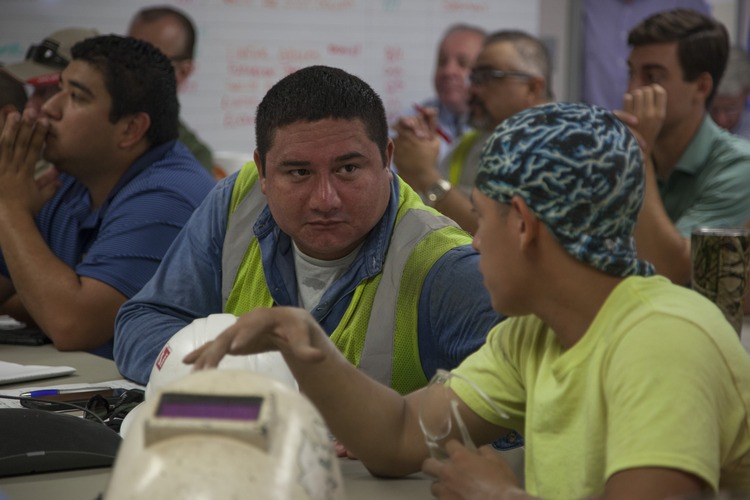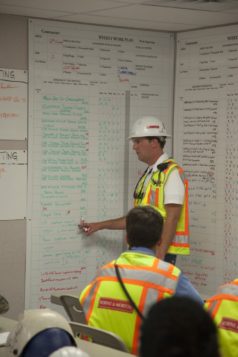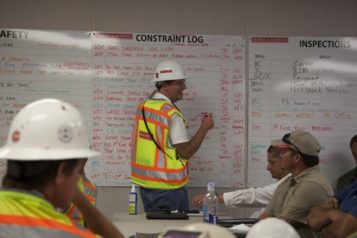
Methods for staying ahead, anticipating future challenges
By Josh Farr
As a superintendent, there are three things that are completely non-negotiable on a job: creating a safe culture on the jobsite, ensuring customer satisfaction and meeting the schedule.
For many, even the word “schedule” can evoke immediate feelings of stress as it can be one of the most obstacle-riddled parts of construction. What makes it that way, is how it ties into every decision a project team makes.
When evaluating safety, there are countless opportunities to ensure safe work planning. While you’re digging into drawings and establishing your job flow, make sure you’re considering what you’ll need in accordance with safety protocol. Although it seems simple, too many times we are focusing on what seems to be more imminent, instead of looking ahead. Ensuring safety protocol is handled long before work begins eliminates the possibility that you will have to halt work entirely to execute, potentially losing hours of work. But most importantly, it eliminates the possibility that anyone would get in a rush to complete their work and adopt the “that’s close enough” mentality. This could lead to severe injury for anyone on the jobsite. Engaging your safety professionals to get their perspectives and insight early in scheduling is invaluable.
In approaching customer satisfaction, schedule drives many of our customers as they are trying to meet operational deadlines. Whether it’s a school making sure their new addition will be ready in time for the first day, or an entertainment facility needing to meet revenue projections, we’re often challenged to meet aggressive schedules. As expected, this can be more difficult for delegation and planning, but the best way to look out for potential challenges is to learn about your client’s business.
I often tell my team that we need to learn what makes this client tick. If we spend time getting to know our clients and learn what makes that specific client successful, we can then schedule to those items or adjust our schedule to accommodate them. For example, a casino’s goal is to maximize revenue. On a recent project, we discussed options of how we could minimize the impact on their projections, and were ultimately able to find a solution, leaving the gaming floor active for a major holiday. Adjusting the schedule to accommodate this was challenging, but because we knew their needs, we were able to leave more than 300 games online, leading to a record-breaking holiday.
Although looking ahead and mitigating potential schedule-impacting issues sounds impossible with all of the other work that goes on each day, it’s much easier to do when utilizing the “last planner system.” The last planner system engages the manager most closely responsible for the upcoming work to make scheduling commitments, making the commitments more reliable. The last planners, often the foremen for the trade contractors, schedule their activities for the week with associated workforce requirements. Each morning, the last planners and the general contractor meet to review progress and discuss prerequisite activities that are necessary for the successful achievement of their commitments in a daily stand-up meeting.
Before the last planner system, we used to set a schedule for the trades and checked their work daily, trying to determine if they were going to make their dates by using the “thumb rule.” Once you realized they weren’t going to make it, it was almost always too late to recover efficiently and made the next course of action extremely reactive.
The last planner system’s daily stand-up meetings give both you and the trades a platform to be proactive, sharing what they plan to complete that week, any constraints they’re facing and what material orders they have on their radar. Addressing all of these on a daily basis gives you time to react quickly and make decisions. The key to this is helping them think ahead by not only planning this week’s work, but also think about what’s coming up in the following weeks and what constraints that may present. In addition to daily stand-ups, it’s also important to hold weekly schedule meetings to help reinforce planning on a more macro level.
One of the most challenging aspects of implementing the last planner system on a project is the job startup. It’s not recommended to try to implement the system mid-project, so the first six weeks are critical to its success. The first thing you have to do is put the boards up on the walls. Make it apparent that you have a strong plan and that you have confidence in that plan. Secondly, you have to teach it. Whether that’s through one-on-one trainings or group on-boardings, it’s important to explain your expectations up front. The worst thing you can do is call out a foreman that’s trying to cooperate at a meeting and embarrass them because you didn’t do your job and train them. Finally, you have to execute. This can be challenging because many who haven’t seen the system work before immediately think it’s “just another meeting.” You have to show the team that it’s a priority, push them to be on time and to meaningfully contribute.
Another significant challenge that comes with last planner system startup is creating a shared understanding that each activity written on the board comes from the near-term schedule and is a commitment, not a goal. Providing adequate detail for each activity and then ensuring accurate reporting of workforce are both key to ensuring the area will be ready for the next trade. We are using those commitments to enable the next contractor in line to efficiently start their work and not be delayed by incomplete prerequisite work. Being able to discuss this openly every day with all contractors on the job earns their buy-in, allows them to see which trade will be in that area the following week and gives them a purpose for completing their work.
Despite commitments, training and schedules, the most important thing on each job is to help the trades understand that you’re on their side. You’re not there to micro-manage; you are a tool to help them get what they need to prevent significant overtime. If they fully engage in the process and put constraints up on the board, you can help them fix the problems that keep them up at night. I always tell my teams to put me in your boat, I can help you paddle.
Ultimately, without trade buy-in, the process will not work. The best method is to praise trade partners who are bought in and engaged. It’s critical to elevate those who help you and help the job move forward. As they excel, others will follow. From there, they will learn to help you anticipate challenges and mitigate schedule-impacting issues. You help them by facilitating communication with one another, having their back and inspiring them to innovate. Each job relies on every person to make it successful. Once we begin to see challenges through our teammates’ eyes and capitalize on the opportunity to learn from one another, that’s when we start driving schedule through teamwork.
Josh Farr is a superintendent with Robins & Morton. He’s a graduate from Auburn University with a Bachelor of Building Science.





 Join our thriving community of 70,000+ superintendents and trade professionals on LinkedIn!
Join our thriving community of 70,000+ superintendents and trade professionals on LinkedIn! Search our job board for your next opportunity, or post an opening within your company.
Search our job board for your next opportunity, or post an opening within your company. Subscribe to our monthly
Construction Superintendent eNewsletter and stay current.
Subscribe to our monthly
Construction Superintendent eNewsletter and stay current.